
The Kawasaki Ninja 250R is a motorcycle in the Ninja sport bike series from the Japanese manufacturer Kawasaki originally introduced in 1986. As the marque's entry-level sport bike, the motorcycle has undergone few changes throughout its quarter-century lifetime, having received only three substantial redesigns. In some markets the Ninja 250R has been succeeded by the Ninja 300.

The Kawasaki GPZ900R is a motorcycle that was manufactured by Kawasaki from 1984 to 2003. It is the earliest member of the Ninja family of sport bikes. The 1984 GPZ900R was a revolutionary design that became the immediate predecessor of the modern-day sport bike. Developed in secret over six years, it was Kawasaki's and the world's first 16-valve liquid-cooled inline four-cylinder motorcycle engine.

The Kawasaki Z500/Z550 series began with the 1979 Z500, a scaled-down version of the Kawasaki Z1R. It used a double-cradle steel frame with a transverse-mounted air-cooled 4-cylinder DOHC engine—a classic Universal Japanese Motorcycle.

The Kawasaki Z650 was a 652 cc (39.8 cu in) standard motorcycle made by Kawasaki from 1976 till 1983. It had a four-cylinder four-stroke, DOHC, air-cooled, wet sump engine with two valves per cylinder and a five-speed gearbox. Designed as a middleweight version of the Kawasaki Z900, the similar-styling had "an attenuated version of the traditional Kawasaki tail fairing". It competed in the market against the smaller SOHC Honda CB650. The Z650 was the epitome of the "Universal Japanese Motorcycle", or "UJM".

The Kawasaki Ninja ZX-10R is a motorcycle in the Ninja sport bike series from the Japanese manufacturer Kawasaki, the successor to the Ninja ZX-9R. It was originally released in 2004 and has been updated and revised throughout the years. It combines an ultra-narrow chassis, low weight, and radial brakes. In 2004 and 2005 the ZX-10R won Best Superbike from Cycle World magazine, and the international Masterbike competition.
The GSX Series is Suzuki's range of sport touring motorcycles powered by four-valve per cylinder four-stroke engines. The first GSX models were introduced in 1980 and represented the next step in Suzuki's four-stroke road bike range after the two-valve GS Series.
The Kawasaki KZ750 L3 a sport bike motorcycle made by Kawasaki starting in 1983. It was very similar to the 1982 Gpz750. This is the year during which the Gpzs made the jump towards "sportbikes", while the KZ line branched off as "sport cruisers". This model can be distinguished by the three horizontal stripes along the gas tank and tailpiece, orange, red and yellow, and the lack of fairing typical on GPZ bikes of the same era. The Kawasaki inline-four engines are considered very robust and reliable. Therefore, this motorcycle, and others with similar engines.
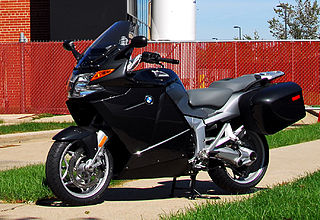
A sport touring motorcycle is a type of motorcycle that combines the performance of a sport bike with the long-distance capabilities and comfort of a touring motorcycle.
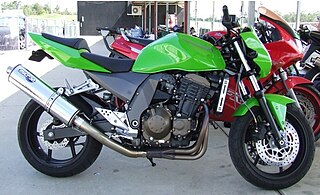
The Kawasaki Z750 is a 750 cc (46 cu in) inline-four engine standard motorcycle made by Kawasaki from 2004 to 2012. It is a smaller version of the Kawasaki Z1000.
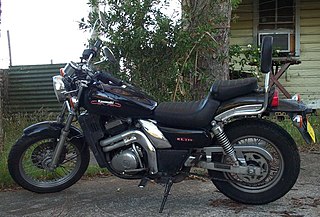
The Kawasaki Eliminator is a cruiser-type motorcycle that has been produced in several variants since its introduction in 1985 as the 900 Eliminator. Currently billed as a "power cruiser", the first two versions of the bike, namely the 1985 Eliminator and 1986 ZL900 models, were almost street replicas of a drag style bike, featuring shaft drive, the ZX900 close-ratio gearbox and forward seating. The engine for both of these machines was the same motor available in the 900ccm Ninja of the same year, albeit with different exhaust and intake configurations.

The Kawasaki Z1 is a four-cylinder, air-cooled, double-overhead camshaft, carbureted, chain-drive motorcycle introduced in 1972 by Kawasaki. Following the introduction of Honda's CB750 in 1968, the Z1 helped popularize the in-line, across-the-frame four-cylinder, a format that became known as the Universal Japanese Motorcycle or UJM.
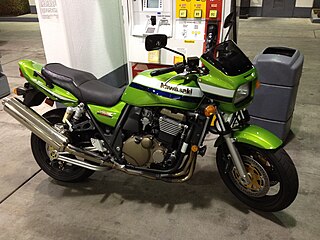
The Kawasaki ZRX1200R, a standard/naked motorcycle, was manufactured in Japan from 2001 until 2007. It was sold in the US until 2005 and Europe until 2007. It was updated in 2008 with a six-speed transmission, fuel injection and was sold exclusively in Japan as the ZRX1200 DAEG model until 2016. It is an evolution of the ZRX1100, a stylized replica of the "Eddie Lawson Replica" KZ1000R sold in 1982, a motorcycle made famous by the superbike racing champion of the same name. With the ZRX1200R, Kawasaki's goal was to produce a motorcycle with the performance of a modern motorcycle, while retaining a design similar to the original Eddie Lawson Replica.

The Kawasaki Ninja ZX-9R is a motorcycle in the Ninja sport bike series from Japanese manufacturer Kawasaki, produced from 1994 until 2003. There were five model incarnations across two basic designs.
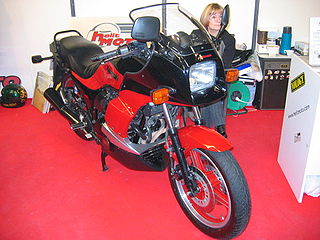
The Kawasaki GPz750 Turbo was a sportbike manufactured from late 1983 to 1985, with two model years – the 1984 E1 and the 1985 E2. Differences were minor, a twin "push/pull" throttle cable for the E2 and different brake caliper stickers. The bike was manufactured in Japan, with parts also shipped to the US and assembled in Kawasaki's Nebraska plant for the US/Canada market to bypass the import tax levied on bikes over 700cc at the time by the US government, a protectionist move designed to save Harley-Davidson which was having financial problems at the time.
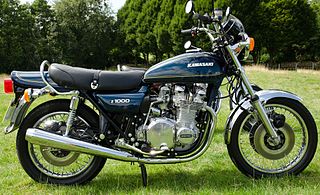
The Kawasaki Kz1000 or Z1000 is a motorcycle made in Japan by Kawasaki, manufacturing commenced in September 1976 for the 1977 model year. The Z1000A1 was an upgraded model to replace the 1976 Kawasaki KZ900 (Z900), which in turn replaced the Z1 launched in 1972 in the Z series. It has an inline-four cylinder engine and a 5-speed transmission, in a 'one down and four up' configuration. Producing about 90 hp, it was one of the fastest production motorcycles of the era. The police model continued in production until 2005.
The Kawasaki GPz1100 B1 and B2 are motorcycles that were manufactured by Kawasaki in 1981 and 1982 respectively. Both models featured a four-cylinder, two-valve air-cooled engine design with a capacity of 1,089 cc. This engine was an evolution of the powerplant used in the previous Kz1000 series, itself descended from the Z1. In 1983 the GPz1100 was completely revamped in both cosmetic styling, suspension and updated engine. The model number changed to ZX1100A1.
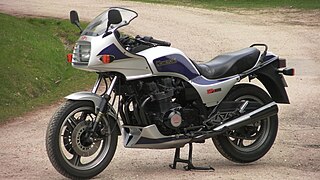
The Kawasaki GPZ1100 is a motorcycle that was manufactured by Kawasaki from 1981 to 1985. All four models featured fuel injection and 1,089 cc engines. All were short lived and were an attempt to fill a market segment that was rapidly changing.
The Kawasaki Z series is a family of standard/naked bikes manufactured by Kawasaki since 1972.
The Kawasaki GPZ1100ABS motorcycle, also labeled GPZ 1100 Horizont, was introduced in 1995. It was a sport touring motorcycle with more focus on touring than sports. Based on a ZZR-1100 motor without the ram air and detuned for more mid-range performance, it also had smaller carburetors and a more restrictive exhaust. The bike was more focused on being economical with budget brakes and suspension. Instead of the Ninjas ZX-11's alloy frame, the bike had a steel double cradle frame with a removable front member for engine removal. The motorcycle had a more relaxed seating position and leg position than the ZX-11D/ZZR-1100 or the air-cooled GPZ1100 of the early 1980s .The official Kawasaki designation was ZX1100E. It also was offered in 1996 as an ABS model.















